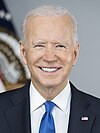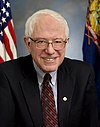Biden-Sanders Unity Task Forces
It has been suggested that this article be merged into Joe Biden 2020 presidential campaign. (Discuss) Proposed since December 2020. |
This article needs to be updated. (November 2020) |
The Biden-Sanders Unity Task Forces are policy development task forces that were created in the wake of the 2020 Democratic Party presidential primaries, in which Joe Biden was elected as the presumptive Democratic nominee, with Bernie Sanders finishing second. Sanders eventually dropped out of the race[1] and endorsed Biden for president,[2] and the two formed a series of task forces. These task forces aim to bridge the divide between the right wing of the Democratic party, represented by Biden, and the left wing of the party, represented by Sanders.[2]
Six task forces were formed, each with members representing each candidate, covering climate change, criminal justice reform, the economy, education, health care, and immigration.[3] The final report was released on July 8, 2020, and is expected to form the basis of the 2020 Democratic presidential platform.[4][5] The six groups were coordinated by Analilia Mejia, political director to the Sanders primary campaign, and Carmel Martin, an advisor to Biden.[5][6]
Committee membership[]
(Italics denotes the Chair of a committee)
Unity Task Force on Climate Change[]
|
Unity Task Force on Criminal Justice Reform[]
|
Unity Task Force on the Economy[]
|
Unity Task Force on Education[]
|
Unity Task Force on Health Care[]
|
Unity Task Force on Immigration[]
|
References[]
- ^ Scott, Dylan (April 8, 2020). "Bernie Sanders ends his second bid for the presidency". Vox. Retrieved July 23, 2020.
- ^ Jump up to: a b Collins, Sean (April 13, 2020). "Bernie Sanders endorses Joe Biden: "We need you in the White House"". Vox. Retrieved July 23, 2020.
- ^ Barbara Sprunt (May 13, 2020). "Biden And Sanders Announce Task Forces To Find Party Unity Over Policy". NPR. Retrieved July 23, 2020.
- ^ Daniel Uria (July 8, 2020). "Biden, Sanders task forces unveil policy recommendations for general election". UPI. Retrieved July 23, 2020.
- ^ Jump up to: a b Beatrice Peterson; Averi Harper; John Verhovek; Molly Nagle (July 10, 2020). "Biden-Bernie Sanders Unity Task Forces release DNC platform recommendations". ABC News. Retrieved July 23, 2020.
- ^ Jessica Corbett (June 24, 2020). "DNC Ignores Progressive Climate Activists". EcoWatch. Retrieved July 23, 2020.
- 2020 United States presidential election
- Bernie Sanders 2020 presidential campaign
- Democratic Party (United States)
- Joe Biden 2020 presidential campaign
- Task forces


